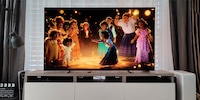

Reviewing the Philips OLED805: great, but with occasional black crush
Hidden behind clashing giants, Philips works away tirelessly at creating solid OLED televisions. At least that's what our readers say. Time to check this out for myself. Is this praise justified?
I haven't yet tested a Philips TV. As noticed by user tel0852 in my article about the Google TV.
[...] By the way, I'm a Philips user and a little disappointed about the few mentions in all your posts. Is there a reason why only Sony and TCL were mentioned?
tel0852 has a point. However, Philips wasn't purposefully excluded at all. I just tend to go for the TVs that interest our readers the most. All according to click rates. But in case you really think something deserves a closer look, best to comment directly which TV I should test. I'll see what I can do.
At the moment, Sony, TCL and LG are definitely ahead of Philips when it comes to televisions. For now, that is. Because Philips – I noticed – has been releasing strong OLED televisions for one or two years now.
Time to take a closer look at the 2020 model.

Just one more thing before we start: Full Disclosure. The 55-inch TV was made available to me by Philips. Due to the pandemic, I had to carry it into the flat myself, before unpacking it and setting it up. Needless to say, there was little time to chat with the delivery man. Sorry Thomas. Maybe next time. With cake, even.
UHD, HDR and the best picture mode ever
Let's start with the connections.
- 3x HDMI 2.0b connectors (HDCP 2.3).
- 3x with ARC, none with eARC.
- All inputs support HLG, HDR10, HDR10+, Dolby Vision and Dolby Atmos.
- 1x Toslink output
- 2x USB 2.0 ports
- 1x LAN port
- 802.11ac Wi-Fi, 2×2 dual band.
- Auto low latency mode for gamers (ALLM)
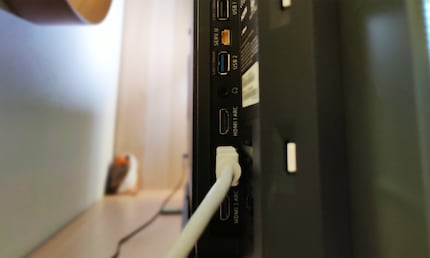
I'm still missing HDMI 2.1. Something gamers will just have to deal with. In order to take full advantage of new next-gen consoles, you'll need enough bandwidth to process the large amounts of data. Namely UHD resolution at HDR quality and 120 frames per second. HDMI 2.0b has a lower bandwidth than HDMI 2.1. That's why there's «only» UHD in HDR quality at 60 frames per second.
Oh well. The TV probably isn't intended for gamers anyway. Even in game mode the OLED805 can't improve input lag above 33.3 milliseconds. The benchmark for good gaming TVs is about 20 milliseconds.
On to the image.
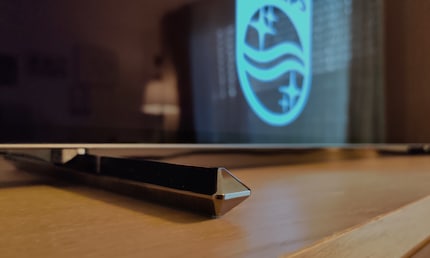
The 2018 dinosaur spectacle «Jurassic World: Fallen Kingdom» will give me first insights. I've seen this film on so many different TVs that I can easily tell what I like about the image, where I spot the imperfections and what it excels at.
Speaking of which, I'll get to «Ambilight», Philip's trademark, later.
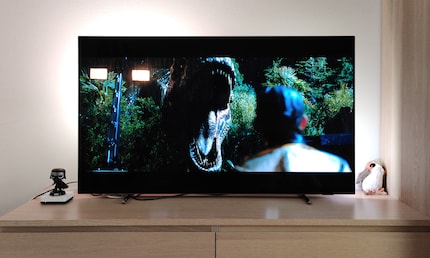
Source: UHD-Blu-Ray, HDR10 quality. Timestamp: 00:05:07
The picture as a whole seems a bit dark. Surprising. OLED TVs are known for their excellent black levels. And also for not removing any details despite «True Black». It's all different here. Inside the maul of a hungry T-Rex, for instance. He seems to swallow details on top of the pitiful parking technician. The tongue ridge, for example. Or the razor-sharp teeth. Also the leathery dino skin to the left of the throat, or the sap green jungle bushes – there's clearly too much detail lost.
Let's compare this with other manufacturers. How about Sony's A8, whose natural colour reproduction I particularly liked during this test scene.
First up, the full-size Philips OLED805:
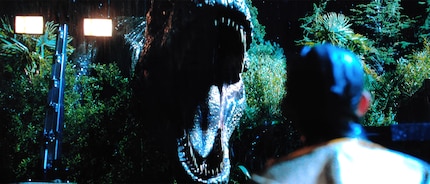
Source: October 2020
And now Sony's A8 for comparison:

Source: September 2020
Weird, right? Nothing against a nice, rich Philips black. It provides contrast with that certain OLED punch; Sony's A8 almost looks pale in comparison. But pay attention to the dark areas of the picture. See how much information is gobbled up there?
This just won't do.
Normally I'd argue that televisions should be tested as they are pre-set when removed from their packaging. «Out of the box», so to say. I want to know how manufacturers imagine the perfect TV image. However, seems like I'll have to make an exception. «Jurassic World: Fallen Kingdom» isn't only an example, but a warning sign regarding the all-consuming dark void known as «black crush». And I can't just spend an entire review blabbering on about some exaggerated black levels. That's just useless.
To the settings we go. With LG, for example, you can specifically correct the black level. Philips contains no such option. Only total brightness, gamma, white balance and contrast. Stupid. I can already see it, fiddling with the image until it works again every time I change the channel – every source triggers a different level of black crush. And depending on the content, you can even mess up other parameters that you don't really want to change.
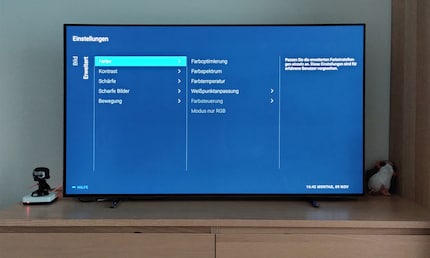
Fortunately, among other presets such as «Standard», «Vivid», «Game» and «Film», I find something better: «AI». A fourth generation A.I., by the way. This activates Philips' «P5 Perfect Picture Engine». The P5 stands for the five Ps:
- Perfect source optimization.
- Perfect contrast.
- Perfect colours.
- Perfect Motion display.
- Perfect image sharpness.
Perfect. My regards to Philips' marketing department for their particularly spirited catchphrase. Essentially, AI mode lets the TV processor filter out, well, «the garbage from the source».
The processor, the brain of the television, receives image signals, processes them and then displays an image. Processing means it removes noise, enhances colours, smooths edges, makes the image (in this case) fluid through Black Frame Insertion (BFI), adds any missing pixel information where the source has no UHD resolution, and enhances the contrast. All TV processors do this, of course. This AI mode is apparently particularly intelligent.
A small, amusing side note: Philips Marketing mentions «razor-sharp contrast», which is about as meaningful as «the meat tastes particularly violet today». Nice try, Philips.
Now on to AI mode:

Source: October 2020
Here's standard mode once again:

Source: October 2020
In AI mode, there's significantly less black crush without the picture looking pale. The artificial intelligence, which according to Philips decides for itself when and how much it intervenes in the picture, didn't simply increase the brightness – which would have caused the rest to fade. It probably made the depths brighter, sharpening them and increasing the contrast. In fact, the green of the jungle now looks even juicier and the leathery skin even sharper. This gives it a higher profile and makes it almost tangible. Great.
Now let's compare it with other manufacturers.

Source: October 2020

Source: September 2020

Source: August 2020

Source: June 2020
The Philips OLED805 lies somewhere between the natural beauty of the Sony A8 and the punchy colour reproduction of the LG GX, which I tested last August. And I have to admit, I enjoy the Philips OLED TV pretty much as it is, even though the black could still crush a little less.
One more thing. I love what the processor does in AI mode with the motion display: everything seems extremely fluid. Especially in action scenes. From hectic camera pans to fast movements in the film. The protagonists run, stumble and stagger away from the dinosaurs. I tried to film it. But you won't make out any difference on camera. Purely with the naked eye.
But if you're not a fan of ultra-smooth motion – I'm talking to you, old-school cinemagoers accustomed to 24 frames per second – you can reduce or eliminate smooth motion in the dedicated AI mode picture settings. This works with all five «Ps» in AI mode, by the way. Suppress less image noise. It's like going back in time. Philips did well in thinking that far ahead.
Next scene.
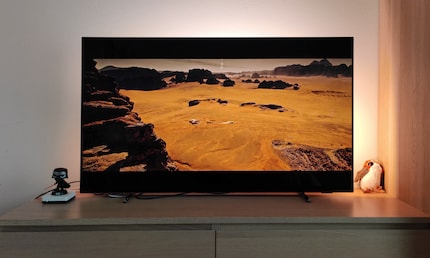
Source: UHD-Blu-Ray, HDR10 quality. Timestamp: 00:42:22
Ridley Scott's «The Martian» is good. Not just as a movie. It's also useful to TV reviewers. Especially during outdoor shots. When a blazing sun creates extremely bright scenes set in a hellish desert. For where there is light, there is also shadow. Especially among the barren rock formations in the middle of the endless dune sea, winding around the formations in all possible shades of orange like an ocean around tropical islands.
I chose this scene as it makes TV processors sweat with its brightness differences. Processing a light or a dark image is one thing. But this gets turned on its head when both extremes occur simultaneously.

Source: October 2020
The orange isn't half bad. That's good. A must in this scene. Forget about store TVs that try to outdo the competition with unnatural exaggerated contrast values. But again: despite «HDR AI», I still lost some significant details among the rocks. There should be more rubble. More structure. Especially among the rear rock formations.
But before you start making up your mind, I'm still only nit-picking in the end. Other manufacturers can't manage much better either. In the end, it's a scene that's damn difficult for TV processors to figure out.
Onto our final UHD-HDR scene.
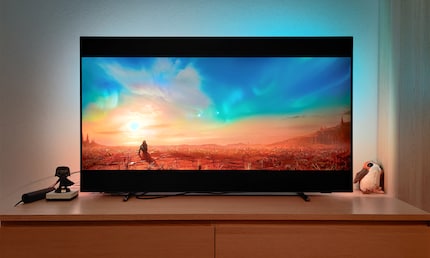
Source: Disney+, Dolby-Vision quality. Timestamp: 01:14:08
Marvel's «Guardians of the Galaxy Vol. 2» must appear like a feast to TV processors. From the breath-taking and all-outshining golden world of the Sovereign to the fantastic colour kaleidoscope of the living planet Ego – there's no need to hold back here.

Source: October 2020
And the Philips OLED805 definitely isn't shy. The processor gets the most it can out of the colours and keeps the balance between light and dark tones amazingly well. For once, no details are lost. Every blade of grass covering the picturesque red planet's surface is wonderfully sharp. And the sun in the background remains nicely visible as a sphere on the orange-turquoise horizon. A clear example of solid brightness gradations.
So far I'm extremely satisfied with the Philips OLED805. Especially in AI mode. But first you'll have to actually figure out how much better it is than standard mode, for example. In my opinion, Philips should place AI mode as the default setting instead of «Standard» mode.
That's how you upscale
Let's look at how well the TV improves content from inferior sources – called upscaling. Blu-Ray or live television for example. Or «The Walking Dead». The series was deliberately shot on 16mm film, so that the old-fashioned grain including image distortion creates the feeling of a broken, post-apocalyptic world.
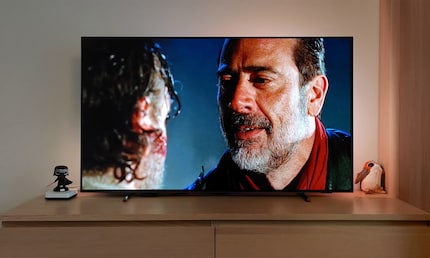
Source: Netflix, HD-SDR quality. Timestamp: 00:02:30
Okay, first impressions are top. Better than Sony's A8, for example. I enjoyed how natural the Japanese OLED TV felt, but I was disappointed with the upscaling. In this respect, LG's GX is my favourite. Let's see how Philips' OLED805 compares.
Once again, the full-size Philips OLED805:

Source: October 2020
I enjoy what the processor does with the background. It's brightened extremely and gets a clear blue cast. The first time I've ever seen it that way. With other manufacturers the background is almost pitch black – you'll see how badly below.
I'm not sure if I prefer it. But I hardly noticed any image noise. Almost no artefacts. Negan's face is sharp, the stubble is clearly visible, as are the dimples on his skin. Upscaling at the highest level.
And here's LG's GX.

Source: August 2020
Still a touch better in my eyes. Although, the differences are minute – apart from the obviously much warmer, redder colour tone. And that speaks for Philips' processor. It's managed to rival LG's A9 processor. Whoa.
Sony's widely praised Ultimate A1 processor didn't even get close:

Source: September 2020
In contrast to Philips and LG, you'll immediately notice that the source is only in HD. 1920×1080. A total of just over 2 million pixels. The processor adds the missing pixel information automatically. UHD televisions have 3840×2160 pixels. That means the processor needs to factor in more than 8.3 million pixels.
In other words, 75% of the image needs to be calculated and created. Philips and LG barely break a sweat during «The Walking Dead». Sony on the other hand...
Ambilight. Not really my thing
Let's move on to Ambilight. Philips' favourite feature, where LEDs at the back of the panel illuminate the wall behind the TV to match the image displayed. The Philips OLED805 has these LEDs mounted on the side and on the top edge.
During an action movie such as «Guardians of the Galaxy Vol. 2» it looks something like this:
I'm not a fan. It distracts significantly from what is happening on-screen. Which is weird, since the declared aim was to create ambilight by «enlarging the picture» – this includes the wall around the TV – to stimulate deeper immersion. Or something like that. I'm not sure how exactly the fine folks over at Philips marketing are envisioning it. To me at least it's not really immersive. It even distracts me whenever I notice it again.
But hey, Ambilight can be switched off at any time. Good choice. Surprisingly, there are ambilight modes that don't make my eyes hurt. Let me give an example: when having guests over (a rare occurrence these days), I enjoy playing some background music over my TV. And thanks to Ambilight, my guests can additionally be entranced by the soothing colours. There's even a music mode where Ambilight doesn't adjust the light to match the picture, but lets it pulsate to match the current song. Hey, now that's something I could see myself using.
I didn't quite understand the other Ambilight modes. For example, «Sport» mode changed absolutely nothing regarding the TV after activation. Here's Philips Marketing: «With Ambilight, you experience action in a more real way. Choose the best TV to watch football and make yourself a little bit comfortable».
A little bit. Uh. Okay.
In the end, Ambilight is only really good for one thing: doubling my electricity bill. Still, it's a unique feature. And it can be integrated into an existing Philips Hue system.
Sound, Smart TV and connections
What surprises me about the Philips OLED805 is its sound. Not necessarily because of the two 10-watt speakers. But because of the additional 30-watt woofer integrated into the panel. It's got a nice bounce. Filling the room well. This makes sounds appear much less tinny or hollow than I had initially feared.
Top marks.
This doesn't exactly apply to the Smart TV function, however. The OLED TV runs on Android TV 9 Pie. So does Sony's A8, by the way. Or TCL's X10. But the Android operating system only really runs smoothly with Sony. Philips' version seems a little slower to me. Not quite as sluggish as TCL, but not nearly as smooth as Sony. By the way, Apple TV support should soon be available, despite the Android operating system. Currently still unannounced by Philips and TCL, but I'm hopeful.
On a better note, Philips' version of Android TV supports both Dolby Vision and Dolby Atmos on Netflix and Disney+. I didn't find any Dolby Vision content on Amazon Prime Video. A rare find, to be sure. The second season of «Jack Ryan» is one such example. However, it only works with HDR10 in my case. It's quite possible that Philips' Amazon Smart TV app doesn't have a license for Dolby Vision.
Verdict
At long last, I have finally tested a Philips OLED TV. Leaving aside the missing HDMI 2.1 support – a must-have for passionate gamers – I could summarise the review in two words: Cool, but.
It's awesome on the one hand, thanks to the rocking Al mode. Despite the overblown hype. No matter whether it's UHD-HDR or HD-SDR material: the picture is crisp, sharp and the colours are bright, but never unnatural. On top of the ultra-fluid movements. A dream.
But, the occasional black crush, which despite optimisations seems a bit too occasional to be an exception, clouds my overall impression. However, I'll definitely keep an eye on Philips TVs in the future. I enjoyed the OLED805 too much to just ignore them. A promise to you, dear readers.
I write about technology as if it were cinema, and about films as if they were real life. Between bits and blockbusters, I’m after stories that move people, not just generate clicks. And yes – sometimes I listen to film scores louder than I probably should.


